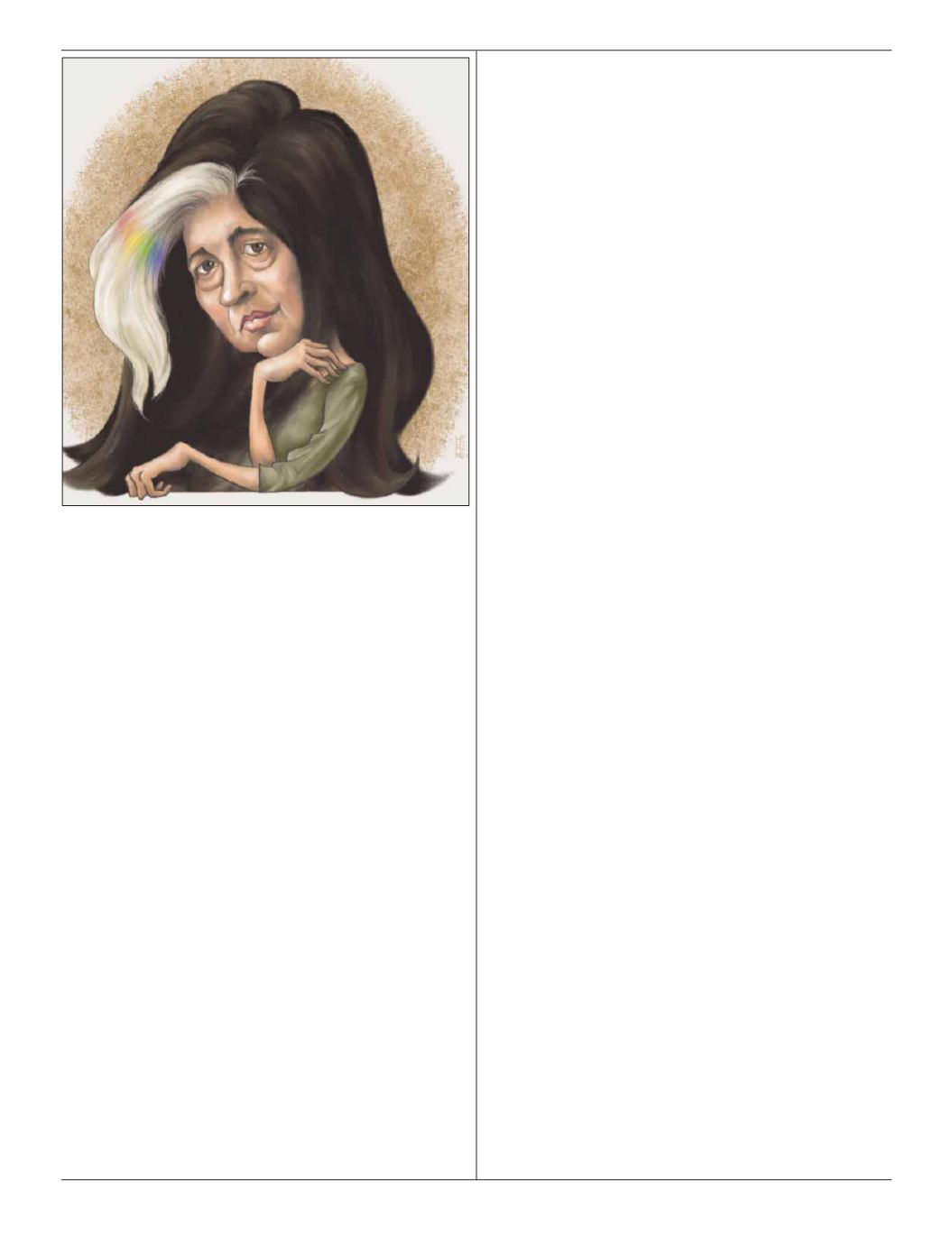

outsiders—a secret code shared among a certain “campiscenti.”
Sadly, most of it falls under the category of “Bad Straight
Camp.”
What is Bad Straight Camp? Examples would include the
exaggerated and stylized streetwalker–stripper fashion co-opted
by many contemporary pop music celebrities, from Rihanna to
Britney and Christina on down, a performative femininity by
females filtered through drag queens that has transmogrified
into an arguably more “avant-garde” style (Lady Gaga, Nicki
Minaj) characterized by hyper-self-referentiality, extreme hy-
perbole, a crudely obvious, unnuanced female sexuality, and
even a vaguely pornographic sensibility which, unhappily, is
post-feminist to the point of misogyny: a capitulation to the
male gaze and classic tropes of objectification to be found only
in the worst nightmares of Laura Mulvey. (Let it be clear that I
am obviously opposed neither to pornography nor to male spec-
tatorship per se, but rather to the continued attempt to erase all
autonomy of women to control their own destinies outside of
their participation in these played-out patriarchal institutions.)
Obviously it’s not the form itself that is reactionary: strippers,
street-smart drag queens, female porn stars, and hookers have
often evinced a radically exaggerated appearance that tran-
scends and deflects patriarchal co-optation. The problem is its
utter and complete normalization and de-contextualization away
from subversive or transgressive impulses in the service of cap-
italist exploitation, utterly heteronormative in practice and cor-
porate in tone.
The great gay camp icons of the past—Barbara Stanwyck,
Tallulah Bankhead, Marlene Dietrich, Mae West—had a sex-
ual ambiguity that extended deeply into real life. (All were ei-
ther practicing lesbians or bisexuals or, in the case of West,
played with androgyny to the degree that her final perform-
ance—her autopsy—was necessary to prove her biological fe-
maleness.) The modern gay camp icons are decidedly straight,
although perversely they still attract throngs of homosexual
admirers, who seem now to prefer their idols to be sexually
conventional females dressed up in extreme and flamboyant
style. One need look no further than battered-wife-syndrome
star Rihanna or super-conventional, baby-bump exhibitionist
Beyoncé, both utterly content to promote themselves tirelessly
in the traditional, subservient wife and/or mother roles. (In-
terestingly, more contemporary camp musical icons like
Michael Jackson and Whitney Houston, who most likely
evinced unorthodox and “deviant” sexuality in their “real”
lives, tend to come to a bad end.) The twin peaks of classic
camp, Bette Davis and Joan Crawford, both had disastrous re-
lationships with their daughters, whose memoirs turned into
camp classics in both cases. Nurturing motherhood and well-
balanced heteronormativity have never managed to co-exist
with great camp.
Other examples of Bad Straight Camp might include the gen-
res of extreme gross-out comedy (the “Hangover” franchise,
Melissa McCarthy movies); certain instances of torture porn (the
horror genre has largely been infused now with a camp sensi-
bility, whether self-consciously, such as the “Scream” franchise,
or not); and last but not least, reality television, including such
camp-fests as
Mob Wives
, the “Real Housewives” franchise,
Toddlers and Tiaras
, and
Jersey Shore
, to name only a few. (The
fact that all are probably gay-friendly does little to ameliorate
their general heteronormative, capitalist and materialist tenor,
with the notable exception of Honey Boo-Boo.)
This new annexation and corruption of the camp sensibility
now exists largely without the qualities of sophistication and
secret signification that were developed out of necessity by the
underground or outsider gay world, which originally created
camp as a kind of gay signifying practice not unrelated to black
signifying, or even black minstrelsy. It was developed as a se-
cret language in order to identify oneself to like-minded or sim-
ilarly closeted homosexuals, a shorthand of arcane and coded,
almost kabbalistic references and practices developed in order
to operate safely apart and without fear of detection from a con-
servative and conventional world that could be aggressively
hostile towards homosexuals, particularly effeminate males and
masculine females. In the contemporary world, in which gays
have largely assimilated into the dominant order, such signify-
ing practices have become somewhat obsolete, and the previous
forms of camping and camp identification have long since been
emptied of camp or gay significance, rendering them easily co-
opted, commercialized, and trivialized.
G
AY
C
ONSERVATIVE
C
AMP
This phenomenon has also led to the rise of what I call “con-
servative camp.” For what are Sarah Palin, Newt Gingrich, Bill
O’Reilly, Donald Trump, and Herman Cain other than conser-
vative camp icons enacting a kind of reactionary burlesque on
the American political stage? Wholly without substance, their
rhetoric exaggerated and stylized, evincing a carefully con-
trived posture of “compassionate conservatism,” they function
merely as a crude spectacle that mocks the unwashed masses by
pretending to be one of them while simultaneously offering
them policies that are directly antithetical to their authentic
needs. Conservative camp has always been around—William F.
Buckley, Jr. is a prime example—but it has now become an en-
tire genre, thoroughly entrenched and embraced by the Amer-
12
The Gay & Lesbian Review
/
WORLDWIDE
Susan Sontag










